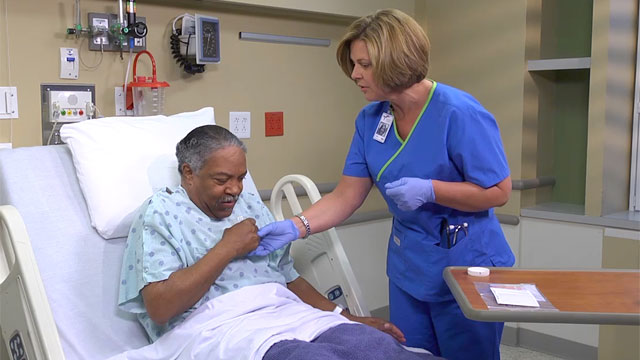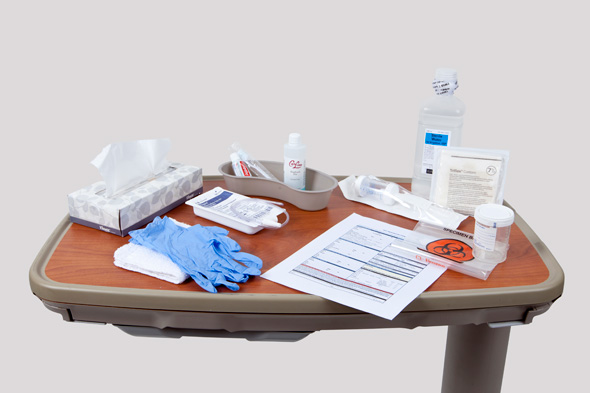Specimen Collection
Select a Skill:
- » Collecting a Midstream Urine Specimen
- » Performing Fecal Occult Blood Testing
- » Performing Gastric Occult Blood Testing
- » Collecting a Sputum Specimen
- » Collecting a Specimen for Wound Culture
- » Performing Blood Glucose Testing
- » Screening Urine for Chemical Properties
Take the Review Test:

Safety
- Follow standard precautions when collecting a sputum specimen.
- Be aware that suctioning, especially for longer than 10 seconds, can damage the respiratory mucosa, lead to hypoxemia and cardiopulmonary compromise, or cause vagal overload, resulting in increased intracranial pressure.
- Obtain a sputum specimen 1 to 2 hours after or 1 hour before a meal, in order to minimize gagging, which can cause vomiting and aspiration.
- If the patient is in respiratory distress during the suctioning procedure, measure the patient’s oxygen saturation with a pulse oximeter.
- If the patient becomes hypoxic with increased respiratory rate and effort and shortness of breath while suctioning:
- Discontinue suctioning immediately.
- Administer oxygen (if ordered).
- Notify the health care provider of the patient’s condition.
- Continue to monitor the patient’s vital signs and pulse oximetry.
Equipment
(Roll cursor over items to see labels)

Sterile specimen container with label
Small biohazard specimen transport bag
Laboratory requisition form
Clean gloves
Emesis basin
Sterile suction catheter (14, 16 or 18 Fr)
Sterile water
Sterile container
Sputum trap
Oral hygiene supplies
Washcloth
Facial tissues
Delegation
The skill of collecting a sputum specimen by suction may not be delegated to nursing assistive personnel (NAP). The skill of collecting a sputum specimen by expectoration and the transporting of either kind of specimen to the laboratory may be delegated to NAP. Be sure to inform NAP of the following:
- Explain the need to immediately report if blood appears in the sputum or if the patient’s vital signs change.
Preparation
- Check the health care provider’s orders for the type of sputum analysis to be performed and for specific parameters of the test, such as the amount of sputum to be obtained, the number of specimens needed, the time at which the specimen is to be collected, and the method by which the specimen will be obtained. Specimens for an acid-fast bacillus (AFB) test for tuberculosis require collection of three consecutive morning samples.
- Assess the patient’s level of understanding of the procedure and its purpose.
- Determine when the patient last ate a meal or had a tube feeding.
- Determine the type of assistance the patient needs in order to obtain the specimen.
- Assess the patient’s respiratory status, including respiratory rate, depth, and pattern, and color of mucous membranes.
Follow-up
- Observe the patient’s respiratory status throughout the procedure, especially during suctioning. If the patient is in respiratory distress, monitor his or her oxygen saturation.
- Be alert for signs of anxiety or discomfort in the patient.
- Observe the character of the sputum: color, consistency, odor, volume, viscosity, and/or presence of blood.
- Refer to the laboratory reports for test results.
- Evaluate the patient’s ability to describe/demonstrate the sputum collection process.
- If an inadequate amount of sputum has been collected, repeat the specimen collection process after the patient takes several deep breaths.
Documentation
- Record the following:
- Method by which the specimen was obtained
- Date and time when the specimen was collected
- Type of test ordered
- Means by which the specimen was transported to the laboratory
- Characteristics of the sputum specimen
- Patient’s tolerance of the procedure
- Report any unusual sputum characteristics to the nurse in charge or to the health care provider.
- When the laboratory reports become available, report any abnormal findings to the health care provider. If an acid-fast bacillus (AFB) sputum culture (tuberculosis test) is positive, initiate appropriate isolation procedures.
- Most agencies require nurses to note on the specimen requisition form if the patient is receiving antibiotics.
Review Questions
1. Why might the collection of a sputum specimen be delayed up to 2 hours?
 The patient is taking an afternoon nap.
The patient is taking an afternoon nap.  The patient has just finished eating lunch.
The patient has just finished eating lunch.  Pain medication has just been administered.
Pain medication has just been administered.  The family is visiting.
The family is visiting.
2. Which criterion makes it appropriate for the nurse to delegate to nursing assistive personnel (NAP) the skill of collecting a sputum specimen?
 The skill takes little time to complete.
The skill takes little time to complete.  The likelihood of infection is minimal.
The likelihood of infection is minimal.  The patient can produce the specimen by coughing.
The patient can produce the specimen by coughing.  The agency offers training in this skill for NAP.
The agency offers training in this skill for NAP.
3. What is the role of nursing assistive personnel (NAP) when a sputum specimen is collected by means of nasotracheal suctioning?
 Manipulating the suction catheter
Manipulating the suction catheter  Setting up the sterile field
Setting up the sterile field  Applying sterile gloves
Applying sterile gloves  Transporting the specimen to the lab
Transporting the specimen to the lab
4. Which action would help to ensure that the results of a suctioned sputum specimen culture are reliable?
 Placing the specimen in a biohazard bag
Placing the specimen in a biohazard bag  Obtaining the specimen when the patient coughs without prompting
Obtaining the specimen when the patient coughs without prompting  Wearing sterile gloves to suction the patient
Wearing sterile gloves to suction the patient  Refrigerating the specimen until it can be taken to the lab
Refrigerating the specimen until it can be taken to the lab
5. Which action by the nurse would most effectively reduce the patient’s risk for injury when collecting a sputum specimen by means of nasotracheal suctioning?
 Lubricating the catheter with sterile water
Lubricating the catheter with sterile water  Performing the procedure using aseptic technique
Performing the procedure using aseptic technique  Positioning the patient in a semi- to high-Fowler’s position
Positioning the patient in a semi- to high-Fowler’s position  Assessing the patient’s degree of anxiety regarding the intervention
Assessing the patient’s degree of anxiety regarding the intervention
You have completed the Review Questions for this skill. To take the Review again select the Start Over button. To proceed to another skill select from the dropdown menu. Select the Home or Back button to proceed to the next section.

